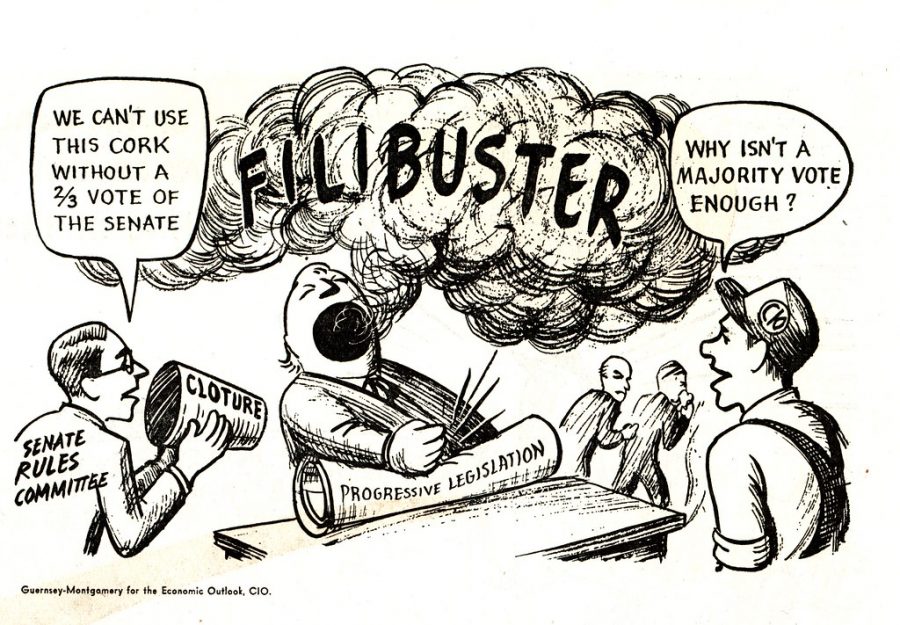The Ongoing Debate of the Senate Filibuster
The senate filibuster, as depicted in the comic, has consistently been used by politicians as a way to counter progressive legislation even if their own party doesn’t hold the majority.
February 17, 2021
After much debate, former Senate Majority Leader Mitch McConnell redacted his demand to preserve the filibuster during the transition of political power in the United States Senate. This came after two Democratic senators, Joe Manchin of West Virginia and Kyrsten of Arizona, voiced the commitment to preserving the filibuster.
The senate filibuster is an attempt to block or delay a bill from being brought to vote. It is used by the minority party in the senate to combat legislation created by the majority party. Republican Senator Mitch McConnell wanted to ensure that the filibuster is protected because it would allow Republicans to maintain their influence in a Democratic-led Congress.
According to the Constitution, the Senate must approve legislation by a majority vote for it to be signed into law. The founding fathers created the majority threshold intentionally, due to their negative experience with a government that operated in a supermajority.
The Articles of Confederation required unanimous support to pass legislation, which made it near impossible to approve bills. By reforming the supermajority margin, the founding fathers hoped to establish a more effective government.
When the filibuster was created in 1806, it effectively required a three fifths majority to pass legislation. After a filibuster is declared, senators can vote to restrict or end debate on a bill. Only with a cloture rule, which requires sixty votes in the Senate, can a filibuster be ended.
“In Article 1 Section 5 of the Constitution, it says that ‘each house may determine the rules of its proceedings, punish its members for disorderly behavior and with the concurrence of two-thirds expel a member.’ So that’s a quote allowing them to create their own rules and proceedings, which is where the filibuster came from,” said AP Government teacher Johanna Heavlin-Martinez.
The filibuster initially involved a senator speaking for an unrestricted length of time on a specific issue or bill. Today, senators do not have to physically speak on the floor in order to delay a bill.
“Basically the point you got to is where the Senate leadership will send an email that’s called a hotline. And this is basically a canvas to say ‘Does anybody plan to filibuster?’ And the reason this was in the Senate leader’s interest is that they would rather know ahead of time if someone was planning to filibuster than bring the bill up and then have it actually run into a filibuster,” said Adam Jentleson, who is a public affairs director at Democracy Forward and a former deputy chief of staff to Senator Harry Reid.
The filibustering process has changed over time to expand the power of the minority, but it’s roots in white supremacy have remained significant throughout history.
“John C. Calhoun needed to increase the power of the numerical minority of senators who represented the slave interests. So what he needed to do was take Madison’s system that had provided a role for the minority and voice for the minority and turn that voice into a veto. In his quest, he invests what we now refer to as the talking filibuster,” said Jentleson.
Due to it’s racist background, the filibuster is often referred to as the “tool of the South.” It has been used to restrict legislation in support of racial equality, especially during the Civil Rights movement.
“Civil Rights bills started to pass the House by enormous margins, and they had popular support, and they had presidents from both parties ready to sign them, and they even seemed to have majority support in the Senate. And so they needed a way to stop them. So the only way to stop these bills from passing was to do Calhoun one better and further increase the power of a numerical minority in the Senate to block what the majority wanted to do,” said Jentleson.
During the Obama administration, the use of the filibuster expanded beyond race-related issues. The filibuster is used constantly today, which creates political gridlock, making it difficult for legislation to be approved. The resulting gridlock is exactly that the founding fathers were attempting to avoid by establishing a majority threshold. It raises the question if the filibuster should be abolished.
“The founders say that it was never supposed to be used as a roadblock, but it is being used that way. And that’s something that the senators have chosen to do and it is their house so they make those decisions,” said Heavlin-Martinez.
The debate around the legitimacy of the filibuster continues. But for now, it remains a vital part of the legislative process.


